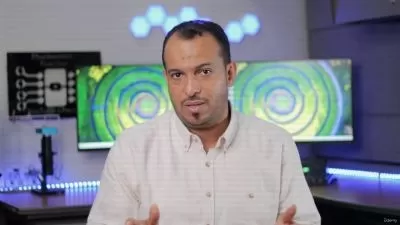Exploring Number Systems-The language of Digital Electronics
Susan Abe
1:20:30
Description
A comprehensive guide to investigate the relationship between number representations, binary arithmetic and binary codes
What You'll Learn?
- Recognize the basic characteristics of the different number systems used in Digital Electronics and counting in each system.
- Convert a number from one number system (decimal, binary, octal, hexadecimal) to its equivalent in one of the other number systems.
- Apply binary Arithmetic operations such as addition, subtraction, multiplication, and division with these number systems.
- Explore the concept of signed numbers and how they are represented in binary and signed binary arithmetic.
- Explore binary codes and discuss the use of number systems in error detection and correction techniques
Who is this for?
What You Need to Know?
More details
Description“This course is not sponsored by or affiliated with Udemy, Inc.â€
The study of number system is important from the view point of understanding how data are represented before they can be processed by any digital system including digital computers. In a digital system, the data is usually in binary states (0 or 1) and are processed and stored electronically to prevent errors due to noise and interfering signals. Digital circuits find applications in computers which accepts data or information in binary as well as Hexadecimal, whereas in the outside world, we humans commonly use the Decimal System. So, it is highly beneficial to learn all these number systems in detail to progress smoothly to the world of Digital Circuit Design.
Discovering Number Systems used in Digital Circuits.
· Familiarize number representation in different number systems.
· Learn the conversion between different digital formats – Decimal, Binary, octal and hexadecimal number system.
· Study simple binary Arithmetic – Addition, Subtraction, Multiplication and Division of Binary Numbers.
· Learn signed number representation & signed number Arithmetic – One’s and Two’s Complement systems.
· Find different Binary Codes – BCD, Gray, Excess-3, ASCII, Error correcting and detecting codes.
Understanding the principles of number representation, conversion & Binary arithmetic.
A number system is a language system consisting of an ordered set of symbols called digits with rules defined for addition, multiplication, and other mathematical operations.
Commonly used Number systems are, Positional Number System & Non positional Number System. The Roman Number System is an example of non-positional number system. Here we are going to discuss the positional Number system consisting of decimal, binary, octal and hexadecimal in detail. Also, we consider binary arithmetic of signed & unsigned numbers. We will be discussing various binary codes to represent the data.
Overview of the course:
Familiarize number representation in different number systems. The characteristics of Decimal, Binary, Octal and Hexadecimal number systems are discussed with specific remarks on the significance of radix (base) of a number system which provides the means of quantifying information for processing by digital systems. The representations of these numbers as integer as well as fractional parts are also discussed.
Next, we consider the Number base conversion techniques between Decimal to Binary, Octal and Hexadecimal systems, conversions of binary, octal and Hexadecimal numbers to Decimal, Binary to octal & Hexadecimal, Octal and Hexadecimal to Binary, Hexadecimal to Octal and Octal to hexadecimal conversions. Such conversions are very helpful in using a particular representation in some specific application.
The third module covers the binary arithmetic. First, we discuss addition, subtraction, multiplication and division of unsigned binary numbers, after that we will see the different representations of signed binary numbers & the binary arithmetic, concentrating more on One’s and Two’s complement representations and arithmetic.
The last module is dedicated for discussion on various binary codes to represent the data. They may consist of numerals, Alphabets or special characters. Mainly we study BCD, Gray code, Excess-3 code, ASCII code and their conversions to other codes. Some practical applications that demand such conversions are also mentioned. Error detection and correction techniques used while transmitting and receiving data in binary form to distant destinations are also discussed. Problem solving sessions are included for all relevant topics.
Who this course is for:
- UG Engineering, Diploma students as well as school students who wish to learn number systems used in Digital Electronics.
“This course is not sponsored by or affiliated with Udemy, Inc.â€
The study of number system is important from the view point of understanding how data are represented before they can be processed by any digital system including digital computers. In a digital system, the data is usually in binary states (0 or 1) and are processed and stored electronically to prevent errors due to noise and interfering signals. Digital circuits find applications in computers which accepts data or information in binary as well as Hexadecimal, whereas in the outside world, we humans commonly use the Decimal System. So, it is highly beneficial to learn all these number systems in detail to progress smoothly to the world of Digital Circuit Design.
Discovering Number Systems used in Digital Circuits.
· Familiarize number representation in different number systems.
· Learn the conversion between different digital formats – Decimal, Binary, octal and hexadecimal number system.
· Study simple binary Arithmetic – Addition, Subtraction, Multiplication and Division of Binary Numbers.
· Learn signed number representation & signed number Arithmetic – One’s and Two’s Complement systems.
· Find different Binary Codes – BCD, Gray, Excess-3, ASCII, Error correcting and detecting codes.
Understanding the principles of number representation, conversion & Binary arithmetic.
A number system is a language system consisting of an ordered set of symbols called digits with rules defined for addition, multiplication, and other mathematical operations.
Commonly used Number systems are, Positional Number System & Non positional Number System. The Roman Number System is an example of non-positional number system. Here we are going to discuss the positional Number system consisting of decimal, binary, octal and hexadecimal in detail. Also, we consider binary arithmetic of signed & unsigned numbers. We will be discussing various binary codes to represent the data.
Overview of the course:
Familiarize number representation in different number systems. The characteristics of Decimal, Binary, Octal and Hexadecimal number systems are discussed with specific remarks on the significance of radix (base) of a number system which provides the means of quantifying information for processing by digital systems. The representations of these numbers as integer as well as fractional parts are also discussed.
Next, we consider the Number base conversion techniques between Decimal to Binary, Octal and Hexadecimal systems, conversions of binary, octal and Hexadecimal numbers to Decimal, Binary to octal & Hexadecimal, Octal and Hexadecimal to Binary, Hexadecimal to Octal and Octal to hexadecimal conversions. Such conversions are very helpful in using a particular representation in some specific application.
The third module covers the binary arithmetic. First, we discuss addition, subtraction, multiplication and division of unsigned binary numbers, after that we will see the different representations of signed binary numbers & the binary arithmetic, concentrating more on One’s and Two’s complement representations and arithmetic.
The last module is dedicated for discussion on various binary codes to represent the data. They may consist of numerals, Alphabets or special characters. Mainly we study BCD, Gray code, Excess-3 code, ASCII code and their conversions to other codes. Some practical applications that demand such conversions are also mentioned. Error detection and correction techniques used while transmitting and receiving data in binary form to distant destinations are also discussed. Problem solving sessions are included for all relevant topics.
Who this course is for:
- UG Engineering, Diploma students as well as school students who wish to learn number systems used in Digital Electronics.
User Reviews
Rating
Susan Abe
Instructor's Courses
Udemy
View courses Udemy- language english
- Training sessions 16
- duration 1:20:30
- Release Date 2024/10/15










